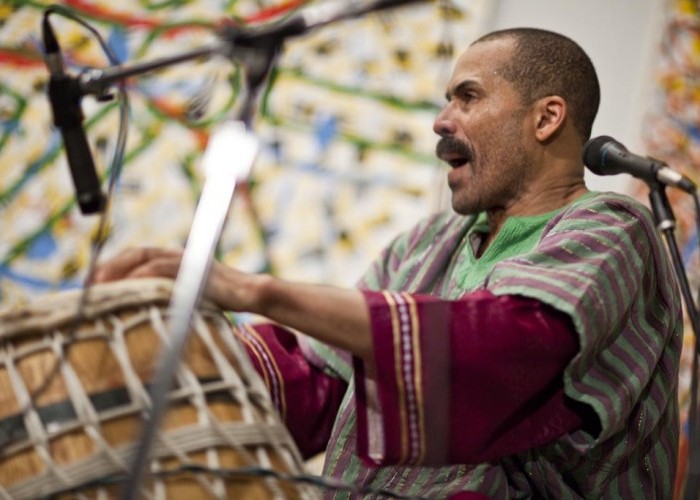Dec 9, 2025 12:28 PM
In Memoriam: Gordon Goodwin, 1954–2025
Gordon Goodwin, an award-winning saxophonist, pianist, bandleader, composer and arranger, died Dec. 8 in Los Angeles.…

Chicago percussionist and bandleader Kahil El’Zabar has a pair of recordings slated for release on Spiritmuse, a new UK imprint.
(Photo: Courtesy Spiritmuse)It’s a unique opportunity to bring these four musicians together under the idea of the science of the groove. It’s not just some sentimental statement. There’s a lot of knowledge that goes into the fervor of building a sound in a groove-based music. Ornette [Coleman] found [bassist] Jamaladeen Tacuma in his youth to be a very exciting player, because he had a natural sense of blending harmonic distinctions along with being able to hold a line, hold a pattern, hold a groove. He was a great foil for the later Ornette Coleman sound, because of his own harmolodic sensibilities. [Saxophonist] Gary Bartz is a master at subtle impact, but he’s got so much knowledge of the instrument from Bird licks to Ornette licks to his own style and his relationship with Pharoah [Sanders] over the years. And [pianist] Robert Irving III has those natural proclivities for composition. That’s what Miles [Davis] saw. The voicings that Bobby had developed and can creatively come up with gave Miles a new kind of sound with his instrument. It made Miles sound better, same thing with Nancy Wilson, Wayne Shorter—so many other people. He worked with me over the years in small ensembles and the large Orchestra Infinity. In a small group with him, you’re always going to get voicings, harmonic sensibilities that’s just going to expand the group.
While you receive so much acclaim in Europe, you’ve stayed rooted in Chicago. What do you see as the city’s importance, especially now?
The 1920s are known as the Jazz Age, accepted worldwide. It started in New Orleans, but it grew up in Chicago. When those musicians went to Europe, it changed the 20th century forever. They brought in a spontaneity, a newness that was considered modernity. Now, with 2020 coming, everyone’s looking at a collective urban sensibility that goes from Nigeria to the suburbs of Paris to São Paulo to Taiwan to Chicago. The idea that with technology and communication across the planet, music and art has become a conduit to humanity, that with all of our diverseness, there’s still some uncommon elements that we can trust in in a real, substantive way.
At the beginning of 20th century, the music of Louis Armstrong, Sidney Bechet and Daniel Burnham’s city plan became influential models, globally. Now, with Chicago being one of the largest fresh water basins in the world, it has developed soul, spirit, energy and become a place of enormous cultural wealth. The artists that come from that core reflect, project and give something that’s received throughout the planet now. DB

Goodwin was one of the most acclaimed, successful and influential jazz musicians of his generation.
Dec 9, 2025 12:28 PM
Gordon Goodwin, an award-winning saxophonist, pianist, bandleader, composer and arranger, died Dec. 8 in Los Angeles.…

Belá Fleck during an interview with Fredrika Whitfield on CNN.
Jan 13, 2026 2:09 PM
The fallout from the renaming of the John F. Kennedy Center for the Performing Arts to include President Donald…

Flea has returned to his first instrument — the trumpet — and assembled a dream band of jazz musicians to record a new album.
Dec 2, 2025 2:01 AM
After a nearly five-decade career as one of his generation’s defining rock bassists, Flea has returned to his first…

“It’s a pleasure and an honor to interpret the music of Oscar Peterson in his native city,” said Jim Doxas in regard to celebrating the Canadian legend. “He traveled the world, but never forgot Montreal.”
Nov 18, 2025 12:16 PM
In the pantheon of jazz luminaries, few shine as brightly, or swing as hard, as Oscar Peterson. A century ago, a…

Dec 11, 2025 11:00 AM
DownBeat presents a complete list of the 4-, 4½- and 5-star albums from 2025 in one convenient package. It’s a great…